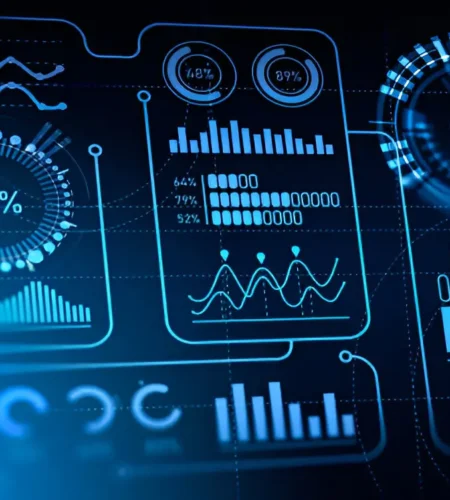How do companies keep their data safe in a fast-moving digital world? One smart way is by using data visualization. It turns raw data into easy-to-read graphs and charts. These visuals help security teams spot threats, track risks, and take quick action.
Data visualization doesn’t just show what happened; it can also show what might happen next. This makes it easier for companies to protect their systems, customers, and future. In this blog, let’s explore eight practical ways data visualization improves business security and keeps threats away.
1. Identifying Unusual Activity Quickly
Data visualization tools help spot patterns and outliers fast. When information is shown in charts or graphs, unusual activity, like a sudden spike in login attempts, stands out right away. This makes it easier for security teams to act before any real damage is done.
For example, line graphs can track user behavior over time. A sudden jump in traffic or failed login attempts might signal a cyberattack. Without visuals, such patterns might stay hidden in lines of raw data.
Visual dashboards provide live updates. This helps companies monitor systems in real time and catch suspicious events early. The clearer the data, the quicker the action. Using simple visuals to highlight abnormal behavior can stop threats before they grow into bigger problems.
2. Tracking Access to Sensitive Data
Keeping an eye on who accesses important files is key to data safety. Visual tools help businesses monitor and record access points. Heat maps and bar charts can show which users opened certain files, when, and how often.
This makes it easier to spot if someone’s looking at data they shouldn’t be. Maybe an employee views a report outside of normal hours. A visual timeline of data access reveals such actions in seconds.
Instead of digging through security logs, teams can use visuals to track user behavior clearly. If something doesn’t look right, they can respond immediately. This improves overall protection by making access monitoring simpler and smarter.
3. Analyzing Cybersecurity Threats
Understanding cyber threats is easier when they’re presented visually. Charts can show the types of attacks, their sources, and how often they happen. This helps businesses know what threats they face the most and where to focus protection.
Pie charts, for example, can break down threat types, like phishing, malware, or ransomware. Using a pie chart maker to market yourself makes complex data easier to understand and share with teams or clients. This helps you easily build trust in your services.
With clear visuals, companies can study past attacks and prepare better defenses. Knowing what kinds of threats happen regularly allows teams to take smart actions, saving time and reducing risk. It turns raw threat data into useful insights.
4. Enhancing Real-Time Monitoring
Security teams must keep an eye on systems at all times. Real-time visual dashboards make this possible. These tools display live data using gauges, charts, and graphs, showing the current status of networks, servers, and user activities.
This live view helps detect issues the moment they happen. For instance, a spike in network traffic could appear as a rising bar on the screen. A visual alarm can notify the team, prompting immediate action.
Instead of waiting for a problem report, teams can act as soon as they see a risk. Real-time visuals bring peace of mind and stronger protection. They also improve team coordination by showing the same clear picture to everyone.
5. Improving Incident Response Planning
Data visualization helps teams prepare for possible attacks. By using charts and diagrams to map out past incidents, businesses can create better response plans. They learn from previous cases and can plan what to do if a similar situation happens again.
Flowcharts can show step-by-step responses to different attack types. This helps everyone understand their role during a security event. Timeline visuals can show how long each response took, helping teams improve their speed.
Having clear visuals makes training easier, too. New staff can learn how to handle incidents by reviewing charts from past events. With strong planning in place, businesses can act fast and reduce damage during future attacks.
6. Monitoring Third-Party Risks
Many businesses work with outside vendors or partners. These third parties can create security risks if not watched closely. Data visualization helps track their access and spot possible problems early.
Graphs can show how often a vendor accesses your system, what areas they touch, and how their usage compares to others. A sudden rise in activity from one partner might signal a threat or policy issue.
Using dashboards, companies can compare vendors side by side. This helps with decision-making and ensures outside partners follow your rules. Visual monitoring keeps your data safe without needing to go through pages of access reports manually.
7. Communicating Security Data to Leaders
Not everyone in a company is a security expert. That’s why data visualization is so useful. It turns complex technical data into simple, clear visuals. This helps business leaders understand risks and make smart decisions.
Instead of reading a 20-page report, a leader can view a dashboard with key metrics. Pie charts, bar graphs, and color-coded alerts quickly show what’s working, and what’s not.
This clear communication also helps when asking for budgets or new tools. Leaders are more likely to approve changes when they see the risks in a simple visual format. Clear charts turn tech talk into smart choices.
8. Protecting Data with Predictive Analysis
One of the best uses of data visualization is predicting future risks. Using past data, visual tools can help forecast where the next threat may come from. These tools highlight weak spots before hackers find them.
For example, heat maps can show which systems are most targeted. Over time, teams can see patterns and plan extra protections where needed. Predictive visuals turn history into action.
Businesses can also track trends, like how fast attacks are growing or which times of year they increase. With this knowledge shown clearly, security teams can take action before a threat even starts.
Start Enhancing Business Security with Data Visualization Now
Data visualization is more than just pretty charts; it’s a powerful tool for keeping businesses safe. From spotting threats in real time to predicting future risks, visuals help companies take smart, fast action. They turn confusing data into clear insights that everyone can understand and use.
Whether you’re monitoring access, studying threats, or training staff, data visuals simplify the task and boost effectiveness. As cyber threats evolve, strong visuals stay a crucial defense. In a data-rich world, clear visuals are vital for protection.
Enjoyed learning about business security? Check out our other blog posts on more topics!


Comments